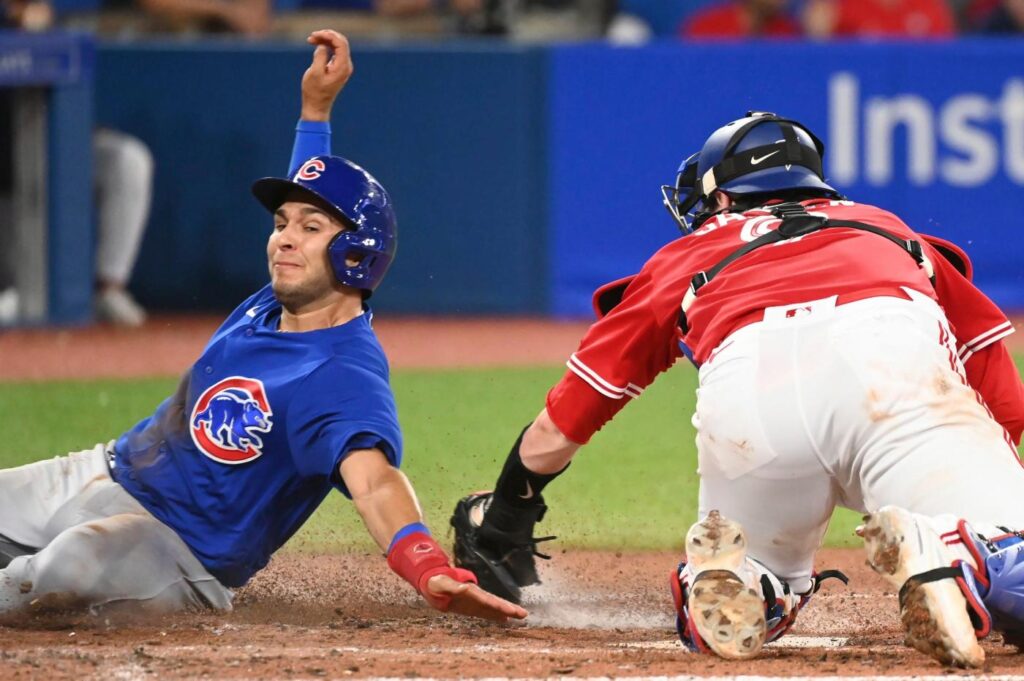
It did not take long for Chicago Cubs infielder Zach McKinstry to learn how his new team approaches baserunning.
The Cubs’ aggressive style has been a seasonlong strategy. Earlier in the year, manager David Ross acknowledged the Cubs needed to adopt that philosophy in an effort to generate more runs based on personnel.
McKinstry, acquired July 30 from the Los Angeles Dodgers, enjoys the Cubs wanting to look for spots to take an extra base. Cubs players also know to always run hard because third-base coach Willie Harris will often look to send them home.
“He’s definitely really aggressive on the basepaths,” McKinstry said Wednesday. “Obviously it wasn’t the same way where I was before. We kind of just went base to base, and if we took the extra base it was because they had a great idea on that guy’s arm or if he’s going side to side and not very good or whatever it is. We’re aggressive, and I like that.”
Recently, though, the Cubs’ baserunning aggression has resulted in too many outs. There is a fine line between smartly taking an extra base and not correctly reading the situation or individual strengths on the basepaths.
During the Cubs’ three-game series in Toronto, they notably made four outs on the bases.
Twice Franmil Reyes cost the Cubs an out in Monday’s 5-4 loss. In the fourth inning, he tried to go first-to-third on Nico Hoerner’s single, and Blue Jays right fielder Ramiel Tapia threw him out. Reyes again cost the Cubs in the 11th when he tried to take second on a bloop single to right field and was easily thrown out.
In the same game, Nick Madrigal tried to score from third on catcher Danny Jansen’s throw to first base on Ian Happ’s swinging strikeout. Vladimir Guerrero Jr.’s throw easily beat Madrigal home for an inning-ending double play.
“You have to be very smart about that,” Reyes said Wednesday. “Aggressive is always a good part of the baseball stuff, but you have to know when to use it. … I have to recognize who I am as a runner, like I cannot make it to every base.”
Ross stated the obvious about the 6-foot-5, 265-pound Reyes, who predominately is a designated hitter at this point in his career: He’s more of a base-to-base runner.
“There’s a professional level that we’re at now where trying to take a base without being a plus baserunner or plus speed probably is a little more risk than we can tolerate,” Ross said. “We’ve got to be responsibly aggressive would be the way I’d put it.”
During Wednesday’s 7-5 victory, McKinstry, situated at third base, was supposed to run on contact as the Blue Jays defense played in with one out in the third. But McKinstry failed to get a good jump and was thrown out at home by second baseman Whit Merrifield.
Whether it’s knowing the scouting report on an outfielder’s arm strength and accuracy or getting a good read on where the ball was hit, multiple factors play into a decision to try to take a base. Ross doesn’t want to take aggressiveness away from players, but he wants better execution and for guys to be smarter when attempting to go for another base in non-steal situations.
The mistakes on the basepaths have put the Cubs among the worst baserunning teams in the majors. They rank second in outs on base (53), including 18 at second and 14 at third. Their 18 outs made at home are second most. Those numbers do not include caught stealings, forceouts or pickoffs.
It hasn’t all been bad baserunning. The Cubs possess an above-average 44% Extra Bases Taken Percentage and notably have gone first-to-third base or home 85 times this year, third best in baseball. But their other baserunning gaffes have become too frequent.
The Cubs must clean up these miscues now while their games have no influence on postseason hopes. It’s an area they will need to address in the offseason and spring training to find the right balance of aggressiveness and situational reads.
“Some of the instinctual-awareness stuff is more game reps, and guys have to understand we’ve got to be responsible and gain context,” Ross said. “The old school don’t make the first or third out at third stuff. It’s just little details.
“Making outs on the bases, giving those away, how hard it is to score runs and running ourselves out of innings, there’s a tolerance for risk that (Monday) we definitely exceeded the manager’s tolerance.”
()
